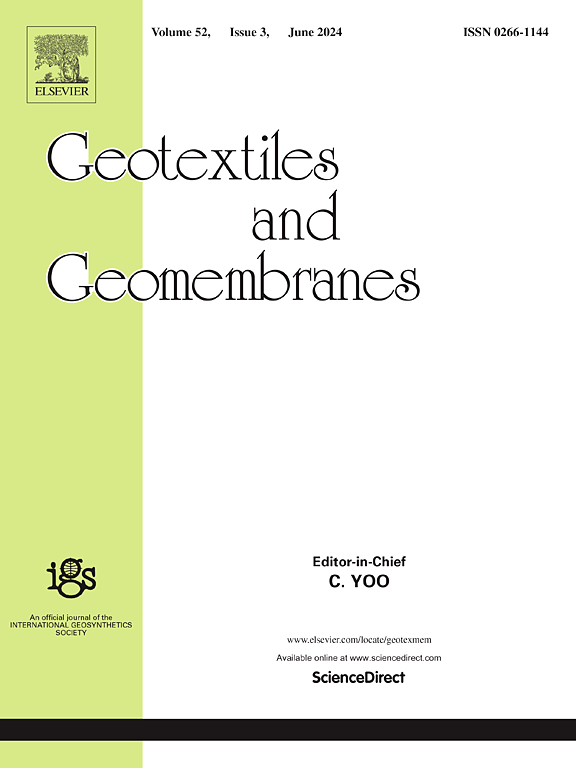考虑到粒径效应的砂土合成相互作用的多尺度行为
IF 6.2
1区 工程技术
Q1 ENGINEERING, GEOLOGICAL
引用次数: 0
摘要
数字成像和传感技术的不断发展有助于更好地理解土壤与土工合成材料之间的多尺度相互作用。在这项研究中,X 射线微型计算机断层扫描(μCT)和轮廓测量等先进技术被用来更好地理解砂和土工合成材料在直接剪切界面试验中的多尺度相互作用。为了涵盖扩张性和非扩张性界面以及不同粒径的砂,在不同法向应力下,对编织土工织物和光滑土工膜与三种分级砂的界面进行了剪切试验。根据颗粒的三维多尺度形态和测试土工合成材料表面的粗糙度分析了不同界面的剪切响应,比较了峰值摩擦角和残余摩擦角以及使用数字图像相关(DIC)技术测定的剪切区厚度。砂-土工织物和砂-土工膜界面的平均峰值摩擦效率分别为 0.84 和 0.52。剪切区的范围随着粒径的增加而增大,其平均厚度为平均粒径的 2.22 至 11.41 倍。在微观层面上,细砂由于单位面积上的有效接触面积更大,因此在土工膜表面引起的剪切变化也更大。本文章由计算机程序翻译,如有差异,请以英文原文为准。
Multi-scale behaviour of sand-geosynthetic interactions considering particle size effects
The continuous evolution of digital imaging and sensing technologies helps in understanding the multi-scale interactions between soils and geosynthetic inclusions in a progressively better way. In this study, advanced techniques like X-ray micro-computed tomography (μCT) and profilometry are used to provide better understanding of the multi-scale interactions between sand and geosynthetic materials in direct shear interface tests. To cover the dilative and non-dilative interfaces and sands of different particle sizes, shear tests were carried out with a woven geotextile and a smooth geomembrane interfacing with three graded sands at different normal stresses. The shear response of different interfaces is analyzed in the light of 3D multi-scale morphology of particles and the roughness of tested geosynthetic surfaces to compare the peak and residual friction angles and shear zone thickness determined using Digital Image Correlation (DIC) technique. The average peak frictional efficiencies for sand-geotextile and sand-geomembrane interfaces are 0.84 and 0.52, respectively. The extent of the shear zone increased with the increase in particle size, with its average thickness ranging from 2.22 to 11.41 times the mean particle size. On a microscopic level, fine sands cause increased shear-induced changes on geomembrane surfaces because of their greater effective contact per unit area.
求助全文
通过发布文献求助,成功后即可免费获取论文全文。
去求助
来源期刊

Geotextiles and Geomembranes
地学-地球科学综合
CiteScore
9.50
自引率
21.20%
发文量
111
审稿时长
59 days
期刊介绍:
The range of products and their applications has expanded rapidly over the last decade with geotextiles and geomembranes being specified world wide. This rapid growth is paralleled by a virtual explosion of technology. Current reference books and even manufacturers' sponsored publications tend to date very quickly and the need for a vehicle to bring together and discuss the growing body of technology now available has become evident.
Geotextiles and Geomembranes fills this need and provides a forum for the dissemination of information amongst research workers, designers, users and manufacturers. By providing a growing fund of information the journal increases general awareness, prompts further research and assists in the establishment of international codes and regulations.
 求助内容:
求助内容: 应助结果提醒方式:
应助结果提醒方式:


